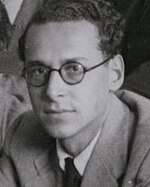利用者:Trunk5772/モーリス・ゴールドハーバー
モーリス・ゴールドハーバー
| |
|---|---|

| |
| 生誕 | 1911年4月18日 |
| 死没 | 2011年5月11日 (aged 100) ニューヨーク州 イースト・セタケット, アメリカ合衆国
|
| 出身校 | ベルリン大学 ケンブリッジ大学 |
| 主な業績 | ニュートリノが負のヘリシティーを持つことの発見 |
| 主な受賞歴 | トム・W・ボナー原子核物理学賞 (1971) National Medal of Science (1983) ウルフ賞(物理学) (1991) ロバート・オッペンハイマー記念賞 (1982) エンリコ・フェルミ賞 (1998) |
| Scientific career | |
| 研究分野 | 物理学 |
| 研究機関 | キャヴェンディッシュ研究所 |
| 博士課程指導教員 | ジェームズ・チャドウィック |
モーリス・ゴールドハーバー (1911年4月18日 - 2011年3月11日)はアメリカの物理学者である。 特に1957年に、リー・グロッシンとアンドリュー・サンヤーと共に、ニュートリノが負のヘリシティー (素粒子)を持つことを実験的に確立したことで知られる。
生涯
[編集]1911年4月18日オーストリア領レンベルク(現ウクライナ領リヴィウ)にユダヤ系の家庭に生まれる。 フンボルト大学ベルリンで物理学を学び、1936年にケンブリッジ大学モードリン・カレッジで博士号を得る。
2011年5月11日にニューヨーク州の自宅で100歳で死去した[1]。
弟のガーソン・ゴールドハーバーはカリフォルニア大学バークレー校で物理学の教授職にあった。 息子のアルフレッド・ゴールドハーバーはニューヨーク州立大学ストーニーブルック校C. N. ヤン理論物理研究所の教授である。 孫(アルフレッドの息子)のデーヴィッド・ゴールドハーバー・ゴードンはスタンフォード大学で物理学を専攻する教授である。
経歴
[編集]1934年キャヴェンディッシュ研究所にてジェームズ・チャドウィックと共に核光電効果を発見し、中性子は陽子と電子に分裂できる分だけ陽子よりも重いことを示した。
1938年にイリノイ大学アーバナ・シャンペーン校に移る。 1940年代に妻とともにベータ粒子と原子内の電子が同一粒子であることを確立させる実験を行なった。
1950年にブルックヘブン国立研究所の一員となる。 エドワード・テラーとともに he proposed that the so-called "giant-dipole nuclear resonance" was due to the neutrons in a nucleus vibrating as a group against the protons as a group (Goldhaber-Teller model).
He made a well-known bet with Hartland Snyder in about 1955 that 反陽子 could not exist; when he lost the bet, he speculated that the reason anti-matter does not appear to be abundant in the universe is that before the Big Bang, a single particle, the "universon" existed that then decayed into "cosmon" and "anti-cosmon," and that the cosmon subsequently decayed to produce the known cosmos. In the 1950s also he speculated that all fermions[2] such as electrons, protons and neutrons are "doubled," that is that each is associated with a similar heavier particle. He also speculated that in what became known as the Goldhaber-Christie model, the so-called strange particles were composites of just 3 basic particles. He was Director of Brookhaven National Laboratory from 1961 to 1973.
Among his many other awards, he won the National Medal of Science in 1983, the Golden Plate Award of the American Academy of Achievement in 1985,[3] the ウルフ賞 in 1991, the ロバート・オッペンハイマー記念賞 in 1982 (shared with Robert Marshak),[4] and the Fermi Award in 1998. He was an elected member of the United States National Academy of Sciences,[5] the American Academy of Arts and Sciences,[6] and the American Philosophical Society.[7]
Legacy
[編集]In 2001, Brookhaven National Laboratory created the Gertrude and Maurice Goldhaber Distinguished Fellowships in his honor. These Fellowships are awarded to early-career scientists with exceptional talent and credentials who have a strong desire for independent research at the frontiers of their fields.
References
[編集]- G. Feinberg, A.W. Sunyar, J. Weneser, A Festschrift for Maurice Goldhaber, New York Academy of Sciences (1993), ISBN 0-89766-086-2
- ^ Kenneth Chang (2011年5月17日). “Maurice Goldhaber, Atomic Physicist, Is Dead at 100”. New York Times 2011年5月18日閲覧. "Dr. Goldhaber was director of the Brookhaven lab from 1961 to 1973, overseeing experiments there that led to three Nobel Prizes. His most famous contribution to science’s basic understanding of how the universe works involved the ghostly, perplexing subatomic particles known as neutrinos."
- ^ Goldhaber, Maurice (2002), “A closer look at the elementary fermions.”, Proc. Natl. Acad. Sci. U.S.A. 99 (1): 33–6, Jan 8, 2002, arXiv:hep-ph/0201208, Bibcode: 2002PNAS...99...33G, doi:10.1073/pnas.221582298, PMC 117509, PMID 11773637
- ^ “Golden Plate Awardees of the American Academy of Achievement”. www.achievement.org. American Academy of Achievement. Template:Cite webの呼び出しエラー:引数 accessdate は必須です。
- ^ “Oppenheimer Prize awarded to Goldhaber and Marshak”. Physics Today (American Institute of Physics) 35 (9): 89. (September 1982). Bibcode: 1982PhT....35i..89.. doi:10.1063/1.2915276.
- ^ “Maurice Goldhaber”. www.nasonline.org. 2022年8月18日閲覧。
- ^ “Maurice Goldhaber” (英語). American Academy of Arts & Sciences. 2022年8月18日閲覧。
- ^ “APS Member History”. search.amphilsoc.org. 2022年8月18日閲覧。
External links
[編集]- BNL celebrates Goldhaber's 90th year
- Description of Goldhaber's spinning neutrino experiment
- Biography of Maurice Goldhaber at Fermi Award website
- Oral History interview transcript with Maurice Goldhaber 10 January 1967, American Institute of Physics, Niels Bohr Library and Archives
[[Category:アメリカ哲学協会会員]] [[Category:ニューヨーク州の科学者]] [[Category:米国科学アカデミー会員]] [[Category:オーストリアのセンテナリアン]] [[Category:アメリカ合衆国のセンテナリアン]] [[Category:ケンブリッジ大学モードリン・カレッジ出身の人物]] [[Category:ユダヤ系オーストリア人]] [[Category:ガリツィア・ユダヤ人]] [[Category:ウルフ賞物理学部門受賞者]] [[Category:エンリコ・フェルミ賞受賞者]] [[Category:アメリカ国家科学賞受賞者]] [[Category:オーストリアの物理学者]] [[Category:アメリカ合衆国の原子核物理学者]] [[Category:2011年没]] [[Category:1911年生]] [[Category:未査読の翻訳があるページ]]
